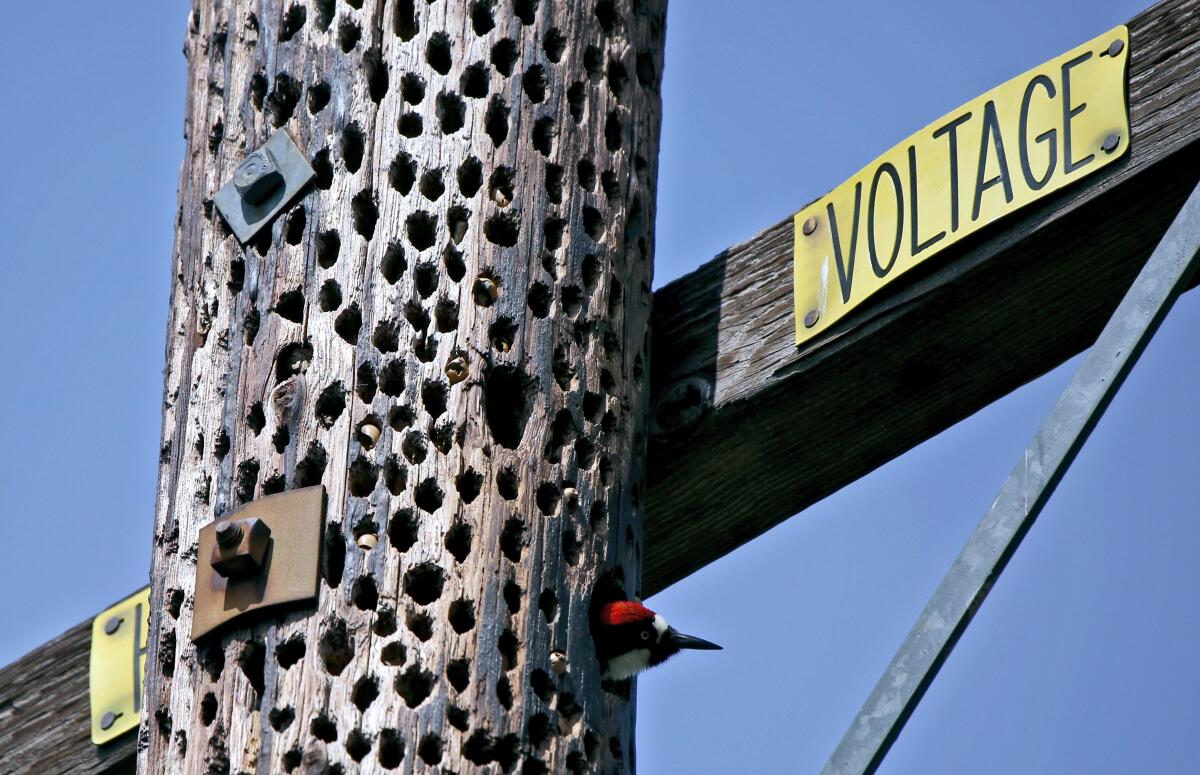Some worry Edison pole replacements could displace woodpeckers that feed, nest inside

As Southern California Edison replaces power poles throughout its service territory, including La Cañada Flintridge and neighboring Altadena, workers are being trained to keep an eye peeled for bird species that may be nesting or roosting in nearby vegetation.
But one tenacious and outspoken bird — the acorn woodpecker (Melanerpes formicivorus) — presents a unique problem. In the soft dead wood of power poles it sees an ideal place to nest, lay eggs and store its namesake food during seasons in which insects aren’t as plentiful.
Suzanne Mitus lives on Altadena’s Chaney Trail in a home whose yard abuts the vastness of Angeles National Forest. Over the years she’s become accustomed to the red-headed birds who make good use of the power pole at the end of her street.
So about a month ago, when an Edison worker placed a tag on the pole announcing it was due for replacement, she and neighbors became concerned for the fate of the resident woodpeckers.
“The birds guard that place — it’s a huge granary and it’s been there for decades,” Mitus said. “Once they make a hole they reuse it, so these holes are permanent or semipermanent homesteads.”
The neighbors called Edison seeking remedy. The utility employs a small team of biologists and contracts with consultants who respond to calls from residents like Mitus concerning the safety of birds nesting in or near power poles.
Avian biologist Kara Donohue said Edison must comply with the Migratory Bird Treaty Act and portions of the California Fish and Wildlife Code, which mandate protection for several bird species along with their nests, eggs and chicks.
Before work is done a biologist will perform a survey of the area and make notes of surrounding bird species, according to Donohue. A similar survey is performed when residents call Edison to report birds seen in a work area. If a nest is discovered, a pole removal will be delayed until chicks are fledged.
In Mitus’s case a worker came out to survey they pole but found no signs of active nesting. Although acorn woodpeckers can lay eggs into October, federal and state protections do not require mitigation efforts if birds are not currently nesting, Donohue said.
“We do not delay work for poles just being used for storing food or roosting,” she said. “Acorn woodpeckers are really, really tolerant [of human activity] and tend to come back once we complete the work.”
Mitus said neighbors realize the poles used by the woodpeckers have to be replaced but are still concerned about a negative impact on the birds living inside.
“I just want [them] to do as little damage as possible and work in a way that enhances our environment,” she said.
Gillian Martin, founder of Orange County-based nonprofit Cavity Conservation Initiative, says woodpeckers provide shelter and food sources for other birds that live and feed inside dead wood but cannot bore their own holes. Residents can help cavity nesters by safely retaining dead trees and limbs on their properties as alternatives to Edison power poles.
Dead trees provide shelter and safety to a number of birds, mammals and reptiles. They also attract insects and fungi that serve as food sources for such species.
“When we remove a dead tree we really deprive the organisms that depend on that dead tree and impact their population,” said Martin, who suggest homeowners consult a qualified arborist to learn about leaving dead trees and branches intact without incurring risk to humans.
Signs available through the group advertise to passersby that a dead or dying tree is being preserved as a wildlife food source or shelter.
“When you do that you change people’s perception of the value of that tree,” Martin said. “It’s an advocacy people can do to let others know this dying tree is fulfilling its final destiny.”
